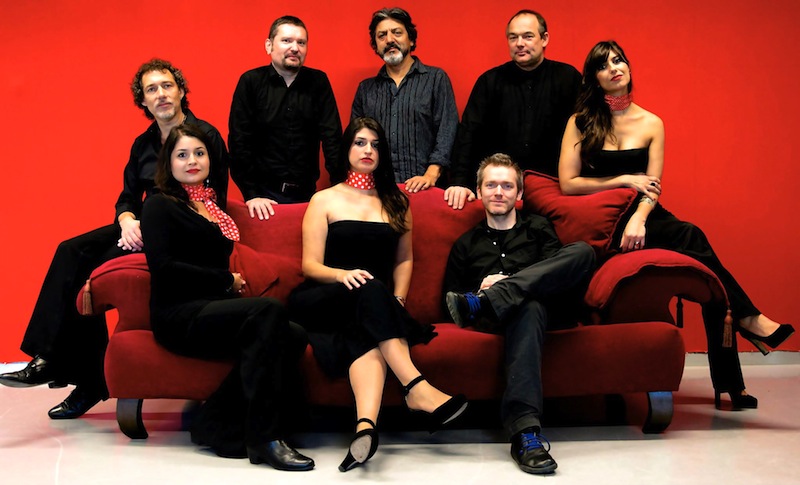New York Classical Review
Música Temprana makes Peruvian program dance in American debut t
October 20, 2015 at 12:02 pm By Sean Piccoli

Música Temprana made its U.S. debut Sunday in the Music Before 1800 series.
When the director of Música Temprana told an audience in Manhattan on Sunday afternoon that this particular program was “not what they call the ‘official’ music of the Baroque period,” he wasn’t kidding.
A world apart from commissions of church and court, “Bailes, Tonadas & Cachuas: Songs and Dances from Trujillo, Peru,” was a veritable bazaar of homegrown music — folkloric songs transcribed by a late-18th Century colonial prelate on assignment for the Spanish crown in South America.
By turns joyful, sad, bawdy, funny, and always deeply rhythmic, the selections–drawn from a mammoth nine-volume codex of everyday Peruvian experience compiled by a far-flung Catholic bishop–came bounding to life in Música Temprana’s stellar U.S. debut.
Music Before 1800, the long-running Baroque and before series, made an inspired pick with this Amsterdam-based group. Música Temprana was led on Sunday at Corpus Christi Church by Adrián Rodriguez Van der Spoel, a native of Argentina who sang and played guitar while also serving as good-humored emcee and historical guide.
The seven-piece archivist ensemble and internationalist cadre — whose name means “Early Music” — played and sang ballads, dance tunes and madrigals arising from more than two centuries of convergence between imperial Spain and indigenous life in Peru.
The program’s lively, populous-sounding opener, “Tonada La Brugita,” was a prototype of how the Spanish song style known as the tonada became a basis of the Peruvian folk music played in that country’s streets, bars, coasts and jungles.
While an exact translation for “brugita” remains elusive, the danceable intent was manifest in this and other imported musical styles that were transformed, beginning in the 1500s, by exposure to local customs, languages and percussion, and by Peruvians also taking up European baroque instruments.
As heard and transcribed by one Baltasar Jaime Martínez Compañón–empire-designated Catholic bishop of Trujillo, Peru, and author of the codex–and interpreted by Música Temprana, this was highly social music. Individual songs played Sunday contained brisk syncopations and tempo changes, male and female voices, and astutely added and subtracted components — both vocal and instrumental.
The effect was absorbing and convivial. The up- and down-tempo alternations of “Cachua de Despedida,” — loosely translated as “Farewell Dance,” suggested a send-off that was cause for both sorrow and elation. “Tonada La Lata,” a racy tale of sailors on shore leave, proceeded like an early variation on tango and, in its metaphorical use of “lata” — a stick for felling trees — left not a lot to the imagination.
There were serious and mournful songs, too — about the murder of Peruvian rebel leader Túpac Amaru (“Tonada De Tuppamaro”) and the lament of a rejected suitor, “Tonadillo El Palomo.”
Arrangements consisting of harp, violin, guitars, bass and percussion were also beautifully sung in varying combinations by Van der Spoel, male vocalist and multi-instrumentalist Gabriel Aguilera Valdebenito and, in particular, their female counterparts: soprano and percussionist Lina Marcela Lopez and mezzo soprano and percussionist Luciana Cueto.
The instrumental trio of Bárbara Ceron on harp, Mónica Weisman on violin and Joshua Cheatham on bass gave the songs their essential colors, contours and depth.
The program ventured briefly beyond Peru with an instrumental, “Quitasol,” traced to Jesuit missions in Bolivia — a style of music still played today in an annual baroque music festival in the Bolivian region called Chiquitana. Música Temprana also presented a handsome, minuet-like instrumental from 1859 with a moorish flavor, “Baile del torito” (“Dance of the little bull”).
The standout on Sunday was an instrumental, “Lanchas para Bailar,” whose title makes reference to dancing on boats — which might explain the song’s challenging, bobbing rhythmic notation. Van der Spoel said that “Lanchas” sorely tested the bishop’s musical abilities, thanks to “a triplet rhythm with a double rhythm inside” that seemed to defy transcription but nevertheless produced an irresistible danceability.
More than period pieces played on baroque instruments; these effusions of Latin rhythm and Western musicality are also just flat-out great finds. They would sound as at home today over the din at a club as they do in a curated concert program. Many, in fact, are still played in Peru, little changed over centuries and as vibrant as ever.
|